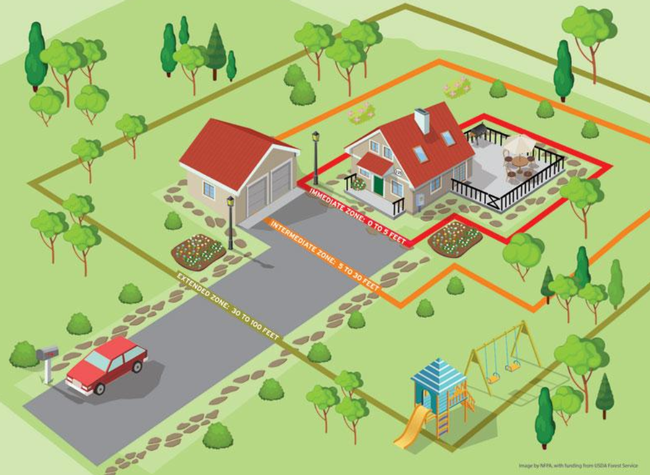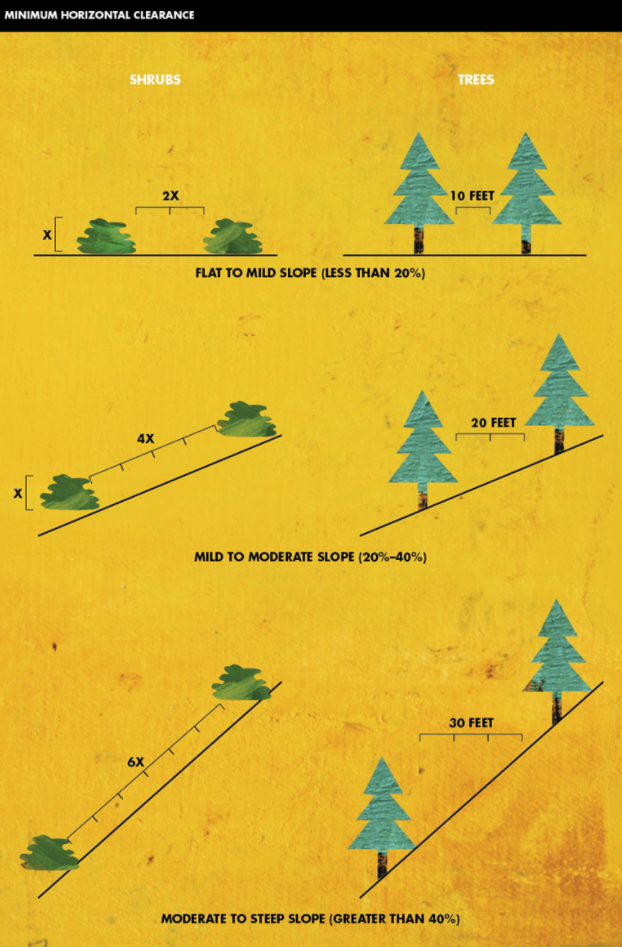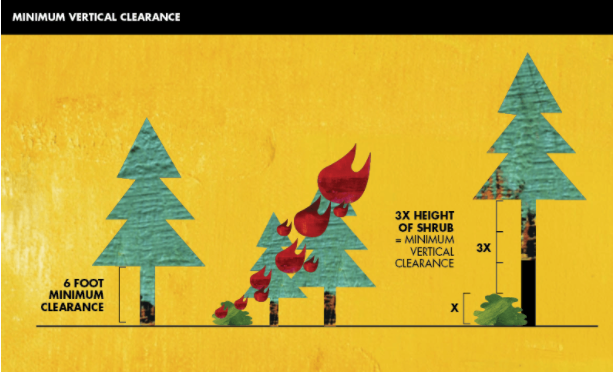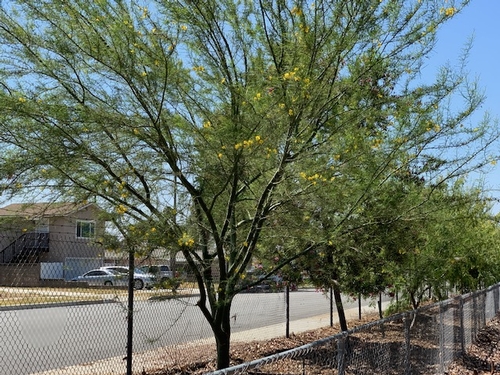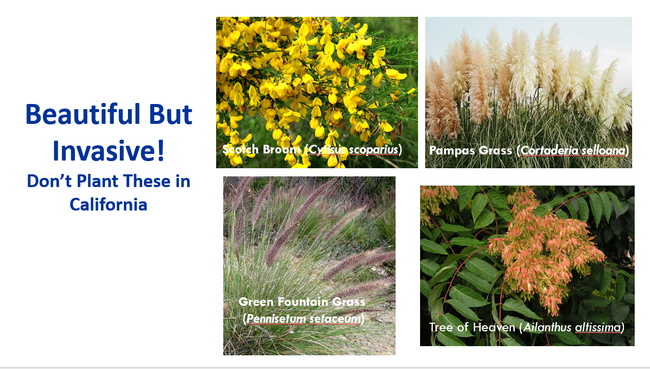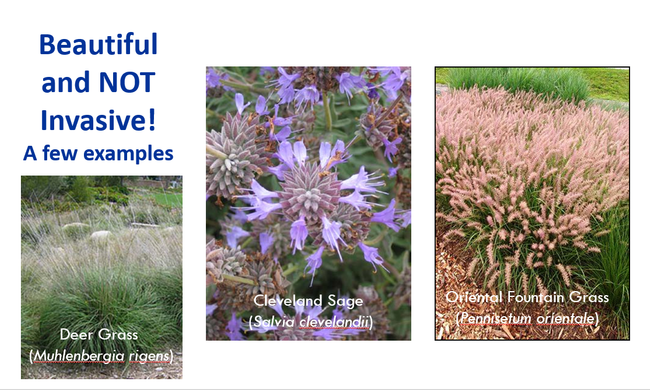- Author: Janet Hartin
Welcome to another “New Normal!” Due to climate change resulting in hotter, drier conditions and reduced snowpack, the occurrence of a “fire season” which traditionally occurred from May through October is becoming a misnomer, with fire occurring throughout the year. The severity of what may lie ahead over the next several months was highlighted in a recent tweet posted by CAL FIRE: “Compared to last year, California has seen over 2,650 more fires and a nearly 2000% increase in the acres burned year-to-date (January 1 – September 7), across all jurisdictions.”
Indeed, Fall often hosts strong offshore winds that can quickly spread destructive fires, exacerbated by the impacts of climate change. What can you do to help ensure ‘defensible space' that increases the safety of your family, pets and property in fire-prone areas? First and foremost, select and properly maintain fire-resistant plants augmented with hardscapes and fire breaks extending from your home to at least one hundred feet outward. (This also helps ensure access to your home by firefighters and other first-line responders in the event of a fire or other life-threatening event.)
Vegetation chosen for your defensible space should have low flammability and can include trees and shrubs along with herbaceous plants. Allowing adequate space between woody plants is important to avoid a continuous fuel path (fuel ladder) where fire starting at ground level can climb to the top of a tree and spread from tree to tree.
1. Follow these ‘defensible space' guidelines to reduce the risk of fire spread and damage:
Zone 0 (first 5 feet from structures): avoid anything combustible including woody plants, mulch, woodpiles, trellises, and stacked items. Instead, add walkways and mulch and other hardscaping made from pebbles and rocks, pavers, rock mulch, or pea gravel. Include a 6-inch noncombustible area extending from the ground to the exterior siding of structures.
Zone 1 (5-30 feet from structures): Eliminate fire spread by ensuring adequate space between trees, removing lower branches. Consider adding irrigated groundcovers or mowed grass or hardscapes between these plant groupings, as well. Properly maintain plants and remove dead portions of plants.
Zone 2 (31-100+ feet from structure to the property line): Concentrate on reducing the density of plants to slow the spread of fire and to reduce the height of flames. Woody plants should be spaced (as illustrated below) to prevent fuel ladders.
Defensible Zones (source: National Fire Protection Association, nfpa.org)
2. Remember that even a so called “fire-resistant” species that is under-watered or otherwise poorly cared for can be highly combustible. The conditions under which the plant is grown influences its fire-resistance more than the species itself. However, plant species high in wax, oil, and resins such as conifers tend to be highly flammable while manzanita and ceanothus (California lilac) are less so.
3. Avoid planting or spreading invasive species. While invasive plants are never recommended in any landscape, they are especially problematic in natural areas prone to wildfire. Once established they can fuel fire as well as crowd out native vegetation and associated habitat. Refer to the California Invasive Plant Council website for more information and specific examples and plants to avoid (www.cal-ipc.org).
4. Follow recommended planting and pruning guidelines to prevent both horizontal and vertical spread from tree to tree. Horizontal spacing is directly related to the slope of the land and the height of the vegetation.
Photo above (courtesy of CAL FIRE) is a diagram to help you determine minimum horizontal clearance for tree and shrub placement to reduce fire risk.
Photo above (courtesy of CAL FIRE) shows a 5' shrub near a tree. In this example, 15' of clearance (3 x 5') is needed between the top of the shrub and the lowest tree branch to prevent a fire ladder.
5. While fire-resistant natives and adapted non-natives greatly reduce your chance of losing your home and property to wildfire, all plants will burn under favorable conditions. Ensure that plants receive adequate irrigation.
6. Rather than applying organic mulch near your home, use non-flammable materials such as stone and pebbles. Granite pathways are also suggested since they provide a fuel break. Firewood and propane tanks should also be kept away from your home.
References:
CAL FIRE “Ready for Wildfire”: https://www.readyforwildfire.org/prepare-for-wildfire/get-ready/defensible-space/
Drill, S. et al. (2009), S.A.F.E Landscapes: Southern California Guidebook, UC Cooperative Extension: https://ucanr.edu/sites/SAFELandscapes/files/93415.pdf
UC ANR “Preparing Home Landscaping for Fire”: https://ucanr.edu/sites/fire/Prepare/Landscaping/
- Author: Janet Hartin
What do more than a dozen community and school garden organizers, members and directors of 15 non-profit boards, several K-12 teachers, a department chair from Loma Linda University a, retired USDA senior marketing manager, a sociologist, an anthropologist, a handful of IT and human resource managers, a structural engineer with a second career as a public health educator and 40 other San Bernardino County residents have in common? They all have a desire to give back to their communities and were recently accepted into our UC Cooperative Extension San Bernardino County Master Gardener program.
The Master Gardener 'class of 2021' hails from all parts of the county including Yucca Valley, Victorville, 29 Palms, Running Springs, San Bernardino, Redlands, Chino, Montclair, Chino Hills, Running Springs, Pinion Pines, Colton, Rancho Cucamonga, Rialto, and Ontario. They will be brought together for the first time ever in the history of the program entirely via Zoom! In exchange for the horticulture knowledge they receive during the 18-week training class, each has agreed to volunteer 50 or more hours helping county residents landscape more sustainably and grow fruits and vegetables in home, community, and school gardens.
Please help Master Gardener Coordinator Maggie O'Neill, our 150+ current Master Gardeners, and me welcome these new students into our program. I am excited to get to know them and inspired already by their passion and giving spirit. Besides helping residents landscape more sustainably, this year the Master Gardener program will focus heavily on helping county residents develop home, school, and community gardens. This closely aligns with the increased interest county residents have in growing food and adopting healthier lifestyles. Master Gardeners are in the process of developing vegetable planting guides for our three main climate zones (valley, high desert and mountains), ‘how to' videos on planting, growing, and harvesting cool and warm season vegetables, and conducting workshops (via zoom for the time being) to help current and new home, community and school gardeners become even more successful. And, of course, Master Gardeners will continue to staff our email and telephone helplines and hope to resume staffing their Farmers' Markets booths as soon as it is safe to do so!
I'm looking forward to another great year!
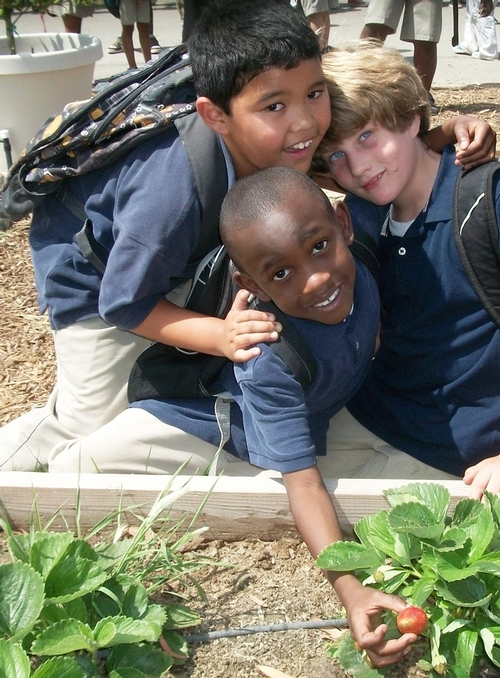
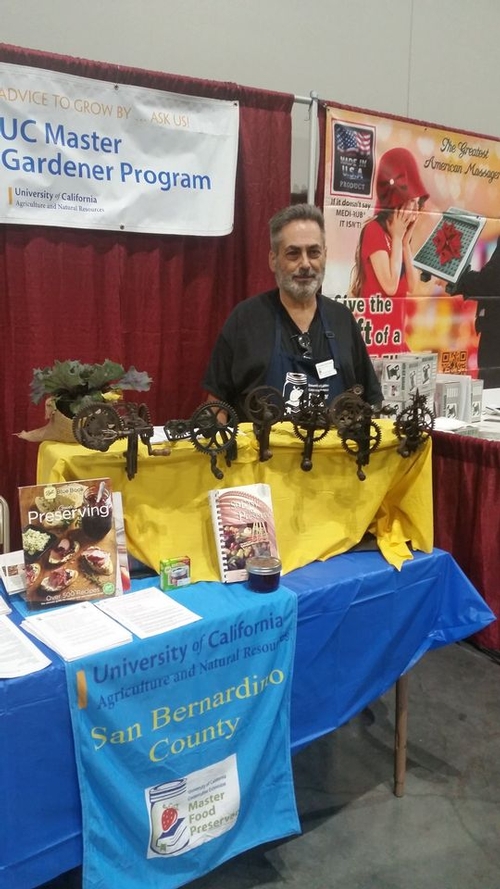
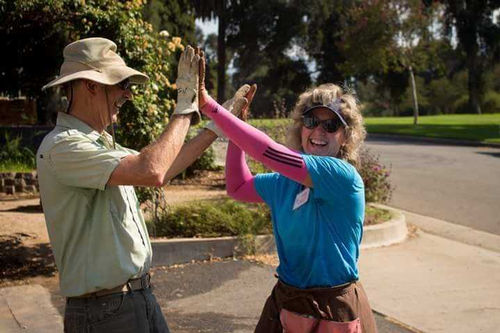
- Author: Janet Hartin
I hope all of you and your loved ones are staying well and healthy as the pandemic continues. Involving yourself in outdoor activities is not only a great way to escape 'cabin fever' and improve your physical health but it is also good for you psychologically, as well.
A silver lining for me over the past few months has been the opportunity to summarize results of some research studies including an update from a mulch trial that I'll report on virtually rather than live at the American Society for Horticultural Science conference (that was to be held in Orlando). I thought you might be interested in the results.
The objective of the research project was to measure the impacts of organic mulch treatments on the growth and health of four species of low maintenance, drought-tolerant landscape trees under deficit irrigation. Species selected were Parkinsonia x ‘Desert Museum' (it's thornless!); Chilopsis linearis ‘Bubba' (Desert Willow) (beautiful magenta flowers!), Pistacia ‘Red Push' (hybrid from P. atlantica and P. integerrima with brilliant orange fall foliage), and Prosopis glandulosa ‘Maverick' (thornless). Trees were planted in a randomized complete block experimental design in at the Chino Basin Water Conservation District (CBWCD) in Montclair in October, 2016. Half of the trees received 4” of organic mulch and half did not. Trees were transplanted from 15-gallon containers and irrigated with recycled water at 80 percent of reference evapotranspiration (ETo) the first 12 months.
Irrigation was reduced to 50% ETo in November, 2017 which was maintained until May 2020, when irrigation ceased. While the study continues through October 2020, there are some interesting early results. Organic mulch applications enhanced growth with no loss in quality in the Pistacia, Prosopis glandulosa, and Chilopsis linearis trees while growth was actually better in the Parkinsonia trees that did not receive mulch. This may be due to the fact that its trunk and branches actively photosynthesize as well as its leaves. Parkinsonia leaves also feature sunken guard cells, providing another form of drought avoidance. Furthermore, they develop deep root systems and may not need the added benefit of reduced soil evaporation in the top few inches of soil provided by the mulch. While all of the species selected have wonderful attributes, the Parkinsonia 'Desert Museum' has all the best traits of its palo verde heritage including having no thorns and a continues bloom throughout summer.
A huge thanks to our UCCE San Bernardino County Master Gardener team (led by Irene) who take data quarterly on the trees, recording trunk circumference at 6" and 3'. This is another great example of the breadth and depth of the contributions of our wonderful volunteers!
The four species of landscape trees in this study are part of a larger study at University of California, Riverside to determine the ability of 12 species of landscape trees to mitigate impacts of climate change. While I'll be long retired, growth and health data of all species will continue to be evaluated through at least 2035. The study at CBWCD provided the opportunity for a mulch/no mulch treatment for four of the most promising species which was space-limited at UCR.
Below are plot photos from October 2016 (right after planting), July 2020 (no irrigation for 3 months), a mature 'Desert Museum' tree in prolific bloom (photo credit to Dr. Bob Perry, Emeritus Professor, Cal Poly Pomona), and a mature Chilopsis linearis 'Bubba' from our UCR plot.
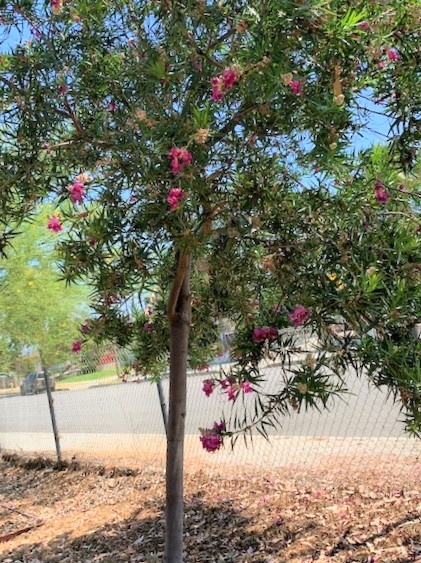
Save the date! We will be hosting a virtual UCR Field Day on September 3, 2020 featuring our drought-tolerant landscape plots at UC Riverside that was to be held live last May. More information is forthcoming but it will provide at least four hours of continuing education hours and a chance for you to ask questions of Dr's Amir Haghverdi, Don Merhaut and myself.
Have a wonderful August in your garden!
Janet
- Author: Janet Hartin
What do ice cream, potato chips, Scotch and Spanish Broom, and Tree of Heaven have in common? While they're all tempting to indulge in, less is more. In fact, plants such as Scotch, Spanish Broom, Tree of Heaven, Pampas Grass, Green Fountain Grass, and dozens of plants are all considered invasive plants in California. Simply put, they should not be planted. There are some great alternative plants that are better choices listed at the end of this blog.
Truth be told, I admit to falling madly in love with the Spanish Broom (Spartium junceum) shrubs adorning Highway 18 on my drive from San Bernardino to Lake Arrowhead in early spring 1984 right after my job interview for my current position. Being a “wet behind the ears” recently hatched graduate student from the Midwest I was truly in awe of their lovely yellow blooms and vowed to plant one if I got the chance to move to California. Fortunately, I found out very soon that, while the plantings were made on purpose, they were a mistake and needed to be removed due to their invasive nature.
While they were ‘recruited' from Europe and had what seemed like a perfect resumé (fast growth, lovely yellow flowers, adaptability to poor infertile soil and disease and insect-resistance), they didn't play well with others, a fatal flaw. In California, they were aggressive and crowded out native plantings. Fires only exacerbated the situation. After the 2003 burns, the Spanish Broom populations exploded, obliterating any remaining natives and taking an even larger area hostage. In summer 2010, the San Bernardino National Forest removed the plants in a costly but necessary $500,000 project under a partnership with the American Recovery and Reinvestment Act. Constant monitoring continues in the San Bernardino Mountains and other areas of the state to prevent its reestablishment which is challenging due to its ability to quickly resprout, seed longevity, and effective dispersal. It has definitely earned its ‘noxious weed' label!
This is just one example of the problems posed by invasive plants. In effect, they grow too well! They outcompete desirable plants in our gardens, lawns, and other urban and natural areas for water, nutrients, and space. They also shade sun-requiring plants. Threatened and endangered plant species and other California native plants are particularly vulnerable to their encroachment. (In most cases, invasive plants are non-native species.) Interestingly, our beloved state flower, the California poppy, is an invasive plant in New Zealand, Hawaii and other locations outside of California.
As urban gardeners, we can all greatly reduce the impact of the encroachment of invasive plants in our urban environments. Please don't plant invasive sane remove plantings on your property to stop their spread. Below are some great resources to learn more about invasive plants and find viable replacements:
California Invasive Plant Council: https://www.cal-ipc.org/
Don't Plant a Pest: https://www.cal-ipc.org/solutions/prevention/landscaping/dpp/
Invasive Plants of Southern California:https://www.cal-ipc.org/solutions/prevention/landscaping/dpp/?region=socal
PlantRight: https://plantright.org/about-invasive-plants/plant
- Author: Janet Hartin
Watch out for these insects! Invasive shot hole borers (ISHB) represent two related species of beetles (polyphagous and Kuroshio) in the genus Euwallacea. Both spread fusarium dieback, a disease that restricts the flow of water and nutrients in the tree, resulting in dead branches, dropped limbs, and even death. Over 60 species of native and non-native ornamental trees and avocados in Southern California are susceptible the ISHB/fusarium dieback complex.Examples of known hosts of the ISHB/fusarium dieback complex include: Box Elder (Acer negundo), Avocado (Persea americana), English Oak (Quercus robur), Valley Oak (Quercus lobata), California coast live oak (Quercus agrifolia), Big leaf maple (Acer macrophyhllum) silk tree (Albizia julibrissin) Liquidambar (Liquidambar styraciflua), Coral tree (Erythrina coralladendron), California sycamore (Platanus racemose), Blue Palo Verde (Cercidium floridum), Purple orchid tree (Bauhinia variegate), Kurrajong (Brachychiton populneus); and many species of Acacia.
The beetles are native to Southeast Asia and were likely introduced into California in shipped goods, wood products, or packaging. While tiny (about the size of a sesame seed), they are prolific, tunneling into host trees and living and reproducing in galleries while feasting on the disease-causing fungus they spread from tree to tree. Females are black and much more common than the small wingless brown males, which are rarely found.
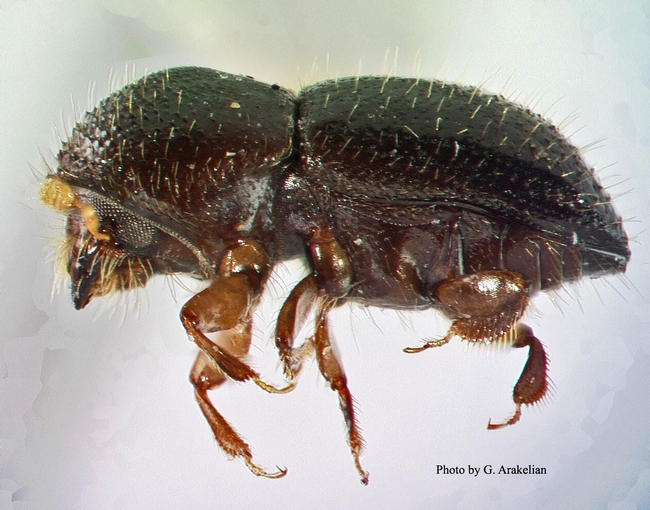
While the initial infestation occurred in Los Angeles County in 2003, beetles travel about 12 miles a year and have now spread fusarium dieback into Orange, San Diego, Riverside, San Bernardino, Ventura, and Santa Barbara Counties. Orange County alone has spent millions of dollars removing infested trees and managing the spread of the ISHB/fusarium dieback complex.
Identifying ISHB in a timely way is essential to reduce damage and slow its spread. Look for round borer entry holes about the size of the tip of a medium ballpoint pen. Staining, gumming, discoloration of wood beneath the bark, and/or frass (sawdust-like material) are other common signs and symptoms. There may also be white powdery exudate around beetle entry holes. Keep in mind that there are many other disorders that have similar symptoms. For example, other fungal diseases produce exudate and staining and other types of borers leave entry holes of various shapes and sizes.
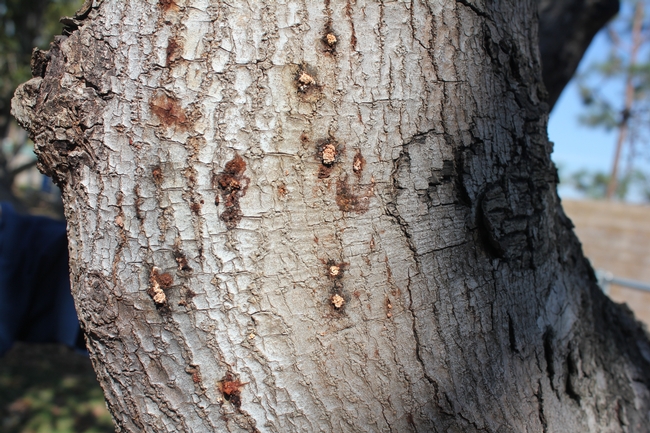
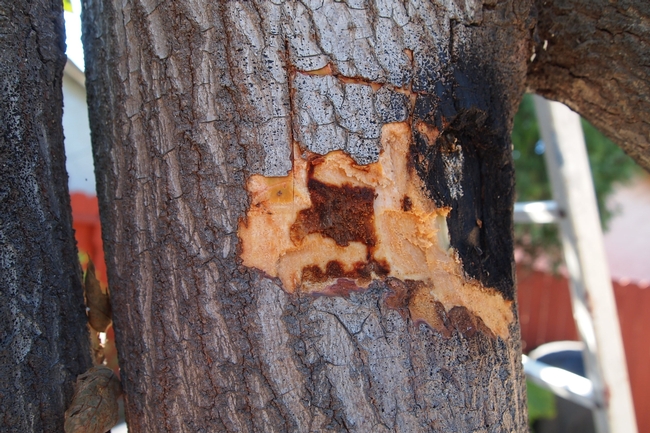
To date, no effective control measures have been found once trees are infested, although entomologists and plant pathologists from the University of California, The USDA Forest Service and other agencies continue to research viable integrated pest management options including biological control.
To prevent and/or reduce spread of ISHB/fusarium dieback:
- Bring only ISHB-free greenwaste (used for mulch and soil amendments) and firewood onsite. Both products can harbor ISHB which can persist for months.
- Treat infected wood onsite whenever possible. Wrap or completely cover wood that cannot be immediately treated and wood that is moved offsite for treatment elsewhere.
- Chipping infested wood to 1 inch or less can kill 95% of the beetles, while solarizing it using a clear tarp eliminates both ISHB and spores produced by the fungus. Logs can also be solarized. Composting is another option that, when done correctly, can kill both beetles and fungal spores.
- Untreated logs, branches, or woodchips infested with ISHB should not be used for firewood or mulch.
- Remove stumps as well as dead trees.
- Follow International Society of Arboriculture pruning standards and never top or flush cut trees which leave open wounds.
- Spray a 70% ethanol solution on equipment and tools since fusarium fungi can adhere to both.
- Keep trees healthy (water mature trees deeply and infrequently, avoid over or under-fertilization, etc.).
- Monitor susceptible tree species often to identify damage as early as possible. Useful detection and reporting tools and more detailed information on the ISHB/fusarium dieback complex can be found here: ucanr.edu/sites/pshb
For more detailed information on the ISHB/fusarium dieback complex, please visit these websites: https://ucanr.edu/sites/pshb/ https://www2.ipm.ucanr.edu/agriculture/avocado/polyphagous-shot-hole-borer-and-kuroshio-shot-hole-borer/ https://cisr.ucr.edu/invasive-species/polyphagous-shot-hole-borer https://californiareleaf.org/pests/

